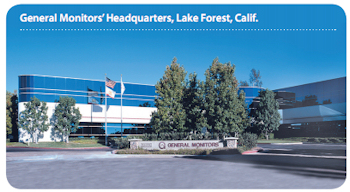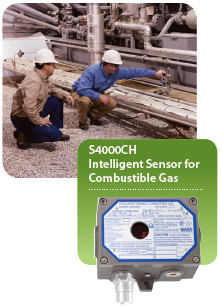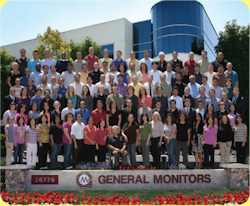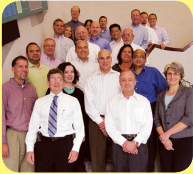2010: The Year of General Monitors
In 2008 MSA implemented a new corporate strategy, which is centered on a commitment to grow MSA's business by focusing on the company's "core products" and committing resources to those products to achieve new levels of success.
At that time, there were three lines defined as core products: Industrial Head Protection, Supplied-Air Respirators (i.e., selfcontained breathing apparatus or SCBA), and Portable Gas Detection Instruments. Notably missing from this list, however, was a long-time MSA product group: Permanent Instruments — a class of fixed gas and flame detection systems installed around workplace perimeters to protect people and property.
As CEO Bill Lambert noted, "During the development of our corporate strategy we identified several important strategic issues related to the long-term growth, viability and external forces facing our permanent instruments business that required a deeper level of internal analysis." Based on this assessment, MSA formed a global team to address the long-range business issues facing this product line.
The conclusion from this in-depth assessment was that MSA's permanent instruments business can and will continue to be a key growth area for the company going forward. And so, in early 2010, the MSA permanent instrument line was designated as the company's fourth Core Product area, with the focus and commitment of corporate resources that comes with such a designation.
The phone rings in Lake Forest
Around that same time the principals of General Monitors (GM) of Lake Forest, California — a global leader in the manufacture of fixed gas and flame detection systems — were having separate discussions about the future of their business. Don Edwards and Phil Robbibaro were beginning to form a conclusion that, for the first time in the company's 50-year history, it was time to seek outside investment to fuel the next era of growth at GM.
Like many companies, MSA maintains a short list of companies it believes would make good potential strategic partners. For many years General Monitors had been on that list. However, it was a serendipitous phone call followed by a face-to-face meeting that would dramatically change the futures of both companies. At that initial meeting, MSA executives, Mr. Edwards and Mr. Robbibaro began to discuss the value creation possibilities that might exist were the two companies to join forces.
MSA and General Monitors: Two Great Companies; One Life-Saving Mission
From the time of those first discussions, all involved were enthused by the similarities in the cultures of the two companies. Both originated from family businesses built on hard work and integrity. Both have a passion for product development and driving new technology. And both have as their corporate mission a commitment to protecting health and saving lives on the job. While MSA is a market leader in multiple safety product categories, General Monitors focuses exclusively on fixed gas and flame detection. And although MSA has an established presence in the fixed gas detection market as well, very little overlap exists between the two companies' respective areas of strength in products and geographic markets. And that fact underscores why both MSA and General Monitors saw an acquisition as such a perfect fit.

For example, General Monitors brings significant strength in the areas of flame detection and hydrogen sulfide detection, areas not historically strong for MSA. GM's new FL4000H Flame Detector, for instance, is a revolutionary development that uses a multispectrum infrared sensor to deliver one of the longest detection ranges in the industry, as well as unprecedented immunity to false alarms, especially in high temperature environments. Conversely, MSA has carved out market leadership positions in protecting areas against a wide range of toxic gases from acetaldehyde to xylene, including carbon monoxide, refrigerants, hydrogen cyanide, benzene and more. Now, together, the two companies deliver the most complete fixed gas and flame detection product portfolio in the industry.
The same complementary relationship can be found from a geographic perspective. General Monitors does significant business in Saudi Arabia, United Arab Emirates, Kuwait, Indonesia, Korea and Colombia, countries where MSA has traditionally had a smaller presence in the market for fixed gas and flame detection products. MSA, on the other hand, has had greater market share in Germany, Italy, the Netherlands, the U.K., Spain, the Czech Republic and Brazil, all countries that have seen less penetration by GM. Industry verticals? Same story. From this perspective, General Monitors is a powerhouse in mining and the oil, gas and petrochemical industries, especially in the drilling and upstream areas. MSA is strong in power generation, food and beverage, wastewater, parking garages and general industrial markets, all segments where General Monitors' offerings are less well established.
The cultural similarities were compelling and the potential synergies exciting to both parties. And so, on October 13, 2010, MSA acquired General Monitors. With the combined strength of General Monitors' and MSA's Permanent Instruments product groups, MSA is now the market leader, representing approximately $200 million of a one billion dollar market, with one third higher market share than the closest competitor.

Maintaining our customer focus
The acquisition of General Monitors is the largest MSA has ever made, and the company is committed to doing it right, not only working to integrate the two businesses seamlessly, but also placing the highest priority on maintaining outstanding product quality, delivery and customer service throughout the integration process.As part of that process, and working in partnership with experts from Deloitte Consulting, the two companies established a joint integration team that includes representatives from GM and MSA covering nine functional areas. Driving this team's progress is a process-driven blueprint designed to ensure that the integration is fully planned and effectively executed.
In addition to this team, Integration Director Nish Vartanian, formerly MSA's Director of Commercial Sales and Distribution for North America, has relocated to GM's headquarters to lead the dayto-day integration process, while Phil Robbibaro, General Monitors' President and CEO continues to oversee GM's day-to-day business, along with GM's functional managers, all of whom were retained in the transaction.

By all indications the integration process is proceeding exceedingly well. Since the "Day One" closing, General Monitors' sales have exceeded MSA's own projections by seven percent. Best of all, the company's industry-leading delivery performance has remained high, and both customer satisfaction and employee engagement, tracked through surveys, have remained at outstanding levels. Going forward, General Monitors and MSA will remain keenly focused on growth, with the goal of seizing greater market share with a complete line of innovative fixed gas and flame detection products. Overall, MSA's newest core product line is expected to be one of the fastest growing for the company.
Growth will come from many avenues. "We will generate new business quickly by expanding channels of distribution and cross-branding certain product lines," said MSA CEO Bill Lambert. "We will share technical know-how to strengthen each others' products for the markets each knows best, and expand on these lines with customer-desired features. We will work together in synergistic fashion to win new business. And, with increased resources and a broader product line, we can confidently work to penetrate markets where neither MSA nor General Monitors has yet to make significant inroads."
"Overall, we will leverage the core competencies that both companies have to offer in order to provide customers with the best solutions available in fixed gas and flame detection technology. And, together, we will grow by delivering greater value to customers than either company could deliver on its own, while also driving a strong return for our shareholders," Mr. Lambert concluded.




